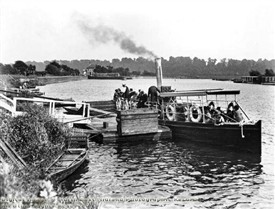Beeston - an Introduction

Pleasure steamboat on the Trent at Beeston, c.1952
www.picturethepast.org.uk
Some descriptions of the town from early county histories and guide books
With its 'Bee Man' sculpture and a bee incorporated in the town crest, it may be popularly believed that the origin of the name has something to do with apiculture.
he name, however, actually derives from the saxon "beos-tun" - Beos meaning bent grass, reeds or rushes, and tun meaning farmstead. Thus we have the farm built for workers to cut and sell reeds to roof thatchers.
Writing in 1910, E.L Guilford in his guide to Nottinghamshire (London: Methuen, 1910, p.56) commented on how the population of Beeston had quickly expanded (and then just as quickly contracted) owing to the arrival - and sudden departure - of the Humber cycle and motor car manufacturing works:-
"Beeston has grown during the last few years from a village into a towngiven over largely to manufacturers.
"The chief cause of this sudden growth was the prescence of the Humber Cycle works, where a very large staff was employed. These works have recently been removed to to Coventry, with the result that the population has decreased by 3000.**
"Excellent boating may be had on the Trent at Beeston, and during the summer months a large number of houseboats take up their stations in this reach of the river".
**The history of Humber motor car manufacturing in Beeston is covered in the book Made in Nottinghamshire. Details HERE
---------------------------------------------